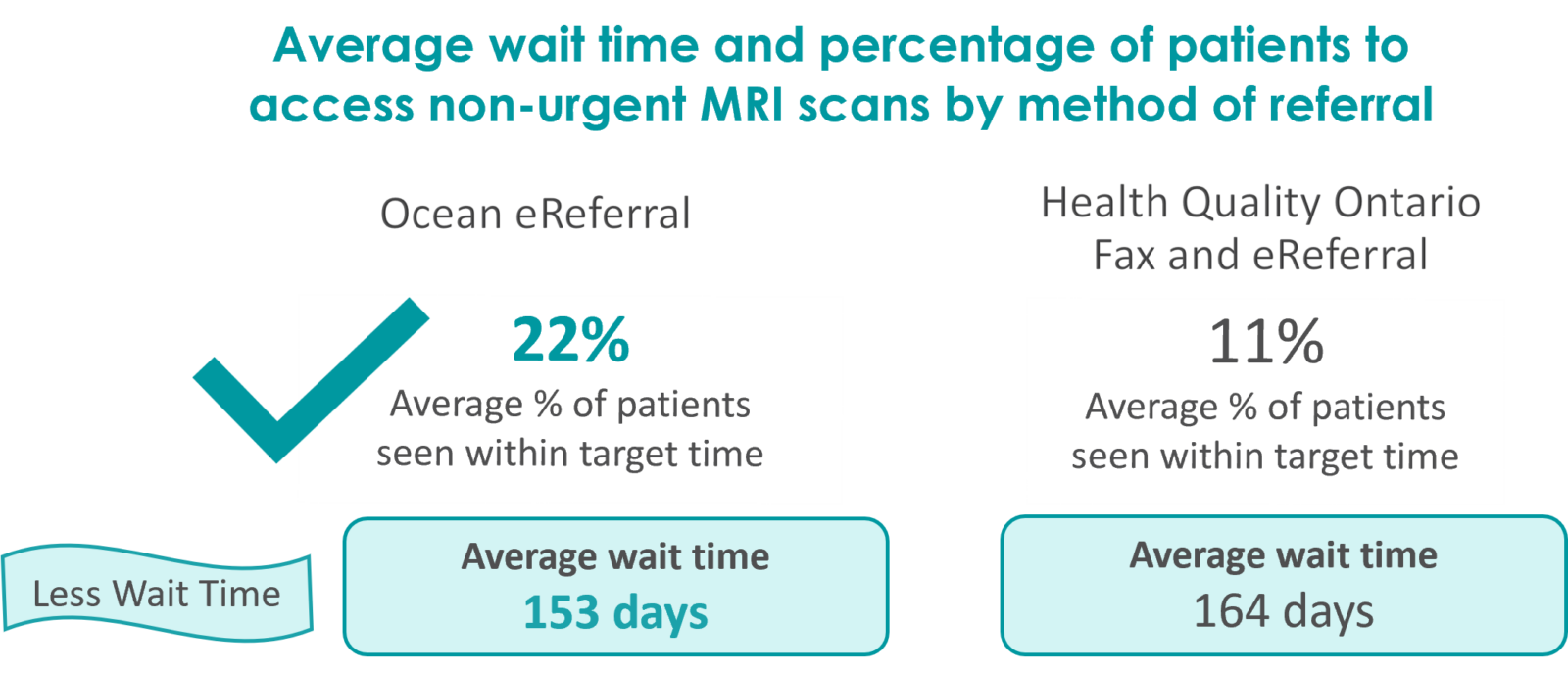Wait times to access routine MRI scans
With the wide availability and direct access to diagnostic technology, MRI has become a more common way to obtain information, especially for clinics with high workloads.² In Ontario, the rate of ordering MRI scans has increased significantly over the past 10 years. According to the Auditor General Ontario (2020) office, non-urgent MRI scans have increased by 8% between 2013/14 and 2017/18.³
Although MRI is considered a sensitive diagnostic tool that can identify many clinical soft tissue lesions, MRI’s low specificity can sometimes inflate false-positive findings and yield only slightly useful results.⁴
Evidence shows that not all ordered MRIs are clinically necessary.⁵ Yet, they maximize patients’ expectations of clinical intervention and entice them towards potentially unnecessary procedures.⁶
In Ontario, with this increase in use, there is a reported upsurge in wait time to receive semi-urgent and non-urgent MRI appointments. Approximately 65% of patients experienced a longer than expected wait time to receive an imaging scan, exceeding the Ministry’s target of a 28 day wait time for non-urgent patients.³
The Ocean eReferral Network adopted the University Hospital Network’s (UHN)⁷ evidence-based diagnostic imaging guidelines, integrating the clinical decision support wording within its electronic forms. These best practice guidelines support clinicians in making appropriate MRI referral decisions and decrease the ordering of unnecessary tests. Ocean eReferral also includes access to a healthmap that allows clinicians to view real-time wait time information by service and location. These efforts work together resulting in decreased wait times for patients to access necessary care.
Key takeaways
The use of electronic referral for diagnostic imaging (DI) requests supports faster access to routine MRI scans and a higher proportion of patients seen within the Ministry’s target time of 28 days.

Key Information
Ocean data
- 233 MRI referrals to Grand River Hospital (GRH) and 155 to Cambridge Memorial Hospital (CMH) were scheduled for appointments using Ocean eReferral in July 2020
- 18% of appointments at GRH and 25% of appointments at CMH were within the target wait time (28 days) with an average wait time of 149 days and 153, respectively
HQO data
- 2% of patients at GRH and 19% of patients at CMH were seen within the target wait time (28 days) with an average wait time of 160 and 164 days, respectively
- Wait time data of non-urgent MRI referrals were reviewed and compared by method of referral for two hospitals in Waterloo-Wellington – Grand River Hospital (GRH) and Cambridge Memorial Hospital (CMH)
- July 2020 wait time data was extracted for eReferrals from the Ocean database, and for all methods of referrals (eReferral and fax) from Health Quality Ontario (HQO)¹
With eReferral, my DI appointment was made soon after request, which is good.
With eReferral, DI appointment is faster than I ever expected.
With eReferral, actually things moved faster than usual
KW area patients
Patient Satisfaction Survey
Acknowledgements
The Ontario eServices Program delivers digital services (eConsult and eReferral are the
first initiatives in the scope of the program) that support clinical workflows and facilitate smoother transitions in care and an improved patient experience. The Ontario eServices Program is co-led by the Ontario eConsult Centre of Excellence (eConsult COE) and the eHealth Centre of Excellence (eCE) and is funded by the Ontario Ministry of Health (MOH).
- Health Quality Ontario. Wait time for Diagnostic Imaging. 2020. Accessed on Nov 2020 from https://www.hqontario.ca/System-Performance/Wait-Times-for-Diagnostic-Imaging
- Smith-Bindman R, Kwan ML, Marlow EC, et al. Trends in Use of Medical Imaging in US Health Care Systems and in Ontario, Canada, 2000-2016. JAMA. 2019;322(9):843–856
- Office of the Auditor General in Onatrio;2020. Annual report. Retrieved December 18, 2020 https://www.auditor.on.ca/en/content/annualreports/arreports/en20/FU_108en20.pdf
- Petron D, Greis P, Aoki S, Black S, Krete T, Sohagia K, et al. Use of Knee Magnetic Resonance Imaging by Primary Care Physicians in Patients Aged 40 Years and Older. Sports Health. 2010; 2(5):385. pmid:23015964
- Smith-Bindman R, Kwan ML, Marlow EC, Theis M, Bolch W, Cheng S, et al. Trends in Use of Medical Imaging in US Health Care Systems and in Ontario, Canada, 2000–2016. JAMA. 2019;322(9):843–856 pmid:31479136
- Canadian Agency for Drugs and Technologies in Health (CADTH). Appropriate utilization of advanced diagnostic imaging procedures: CT, MRI, and PET/CT; 2015. Retrieved June 24, 2020
- The Joint Department of Medical Imaging- University Hospital Network (UHN) DI App- Online Imaging Guidelines Pathway. 2018. http://pathways.coralimaging.ca/about.php
Interested in learning more?
Interested in partnering with us or learning more about
what we can offer you? Please reach out here.
Get the latest resources and insights
-

eReferral reduces processing time from clinician to central intake
Background or some context should ideally go here. Lorem ipsum dolor sit amet, consectetur adipiscing…
-

Webinar on systematically reimagining administrative load in family practice
Sharing some tips, tricks, and key takeaways from our Ideal Primary Care Practice Model webinar,…
-

Waterloo Wellington cataract central intake
The Waterloo Wellington Cataract Central (CI) Intake was established in April 2021; in a 5-month…
-

eReferral annual user satisfaction survey September 2022 – increase in usage
The Ontario eServices Program deploys a User Satisfaction Survey once a year in order to gather…